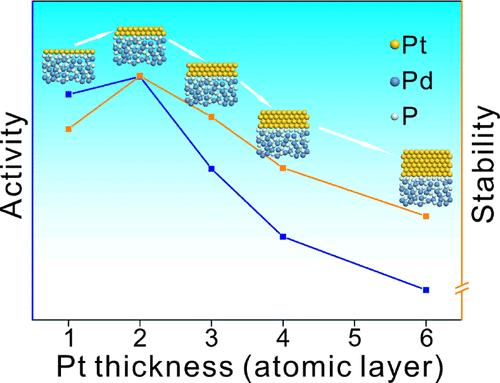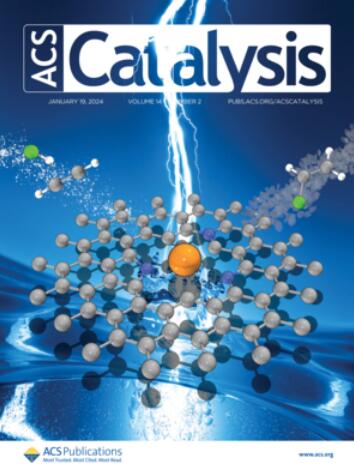Effect of Interfacial Interaction on Electrocatalytic Activity and Durability of Pt-Based Core–Shell Nanocatalysts
IF 11.3
1区 化学
Q1 CHEMISTRY, PHYSICAL
引用次数: 0
Abstract
Pt-based core–shell nanoparticles have presented a promising generation of high-performance electrocatalysts for proton-exchange membrane fuel cells, with their catalytic performance primarily dependent on the interfacial interaction between the core and Pt shell. Here we systematically investigated the impact of interfacial interaction on electronic structure and electrocatalytic performance by using Pd@Pd–P@Pt core–shell octahedra with precisely controlled shell thicknesses as a well-defined platform. Experimental and theoretical calculation results demonstrate that the Pt–P interfacial interaction would lower the d-band center and increase the vacancy formation energy of Pt sites, thereby substantially enhancing both the activity and durability of the oxygen reduction reaction. Such enhancement effect is highly dependent on the distance between the interface and the Pt sites, which can be tuned via careful manipulation of the shell thickness. Once the shell thickness exceeds 6 atomic layers, the enhancement effect of interfacial interaction on the catalytic performance becomes negligible.

界面相互作用对铂基核壳纳米催化剂电催化活性和耐久性的影响
铂基核壳纳米粒子是质子交换膜燃料电池中很有前途的一代高性能电催化剂,其催化性能主要取决于核壳与铂壳之间的界面相互作用。在此,我们以精确控制壳厚度的 Pd@Pd-P@Pt 核壳八面体为定义明确的平台,系统地研究了界面相互作用对电子结构和电催化性能的影响。实验和理论计算结果表明,铂-钯界面相互作用会降低铂位点的 d 带中心,增加铂位点的空位形成能,从而大幅提高氧还原反应的活性和持久性。这种增强效应在很大程度上取决于界面与铂位点之间的距离,而这可以通过仔细调节外壳厚度来调整。一旦外壳厚度超过 6 个原子层,界面相互作用对催化性能的增强效果就可以忽略不计了。
本文章由计算机程序翻译,如有差异,请以英文原文为准。
求助全文
约1分钟内获得全文
求助全文
来源期刊

ACS Catalysis
CHEMISTRY, PHYSICAL-
CiteScore
20.80
自引率
6.20%
发文量
1253
审稿时长
1.5 months
期刊介绍:
ACS Catalysis is an esteemed journal that publishes original research in the fields of heterogeneous catalysis, molecular catalysis, and biocatalysis. It offers broad coverage across diverse areas such as life sciences, organometallics and synthesis, photochemistry and electrochemistry, drug discovery and synthesis, materials science, environmental protection, polymer discovery and synthesis, and energy and fuels.
The scope of the journal is to showcase innovative work in various aspects of catalysis. This includes new reactions and novel synthetic approaches utilizing known catalysts, the discovery or modification of new catalysts, elucidation of catalytic mechanisms through cutting-edge investigations, practical enhancements of existing processes, as well as conceptual advances in the field. Contributions to ACS Catalysis can encompass both experimental and theoretical research focused on catalytic molecules, macromolecules, and materials that exhibit catalytic turnover.
文献相关原料
公司名称
产品信息
阿拉丁
Acetic acid
阿拉丁
Perchloric acid
阿拉丁
Cyclohexane
阿拉丁
Isopropanol
 求助内容:
求助内容: 应助结果提醒方式:
应助结果提醒方式:


